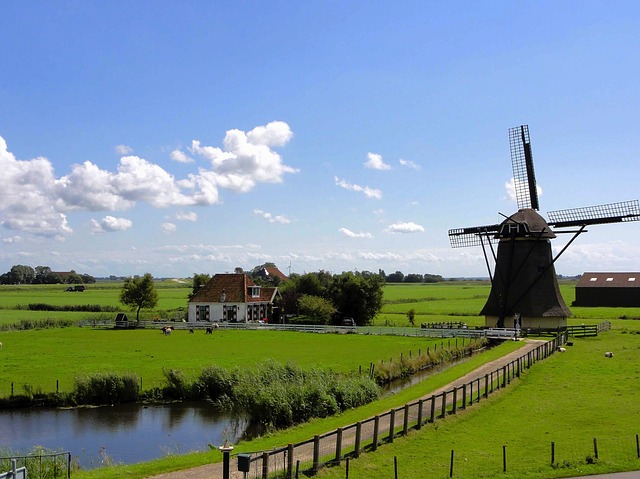A new study, published in the British Journal of Psychiatry Open, examines the association between mental health and access to green or blue spaces near one’s residence. The results of the study, conducted in the Netherlands, support the theory that individuals who live near green space or water have better mental and physical health outcomes.
“The present results also strongly suggest that with regard to mental health, blue space should not be overlooked and deserves more systematic attention in future research,” state the authors, led by Sjerp de Vries from Wageningen University & Research.
Many studies have investigated the impact of nature on wellbeing. Studies examining the effects of green space have mostly found positive associations for physical and mental health, especially for anxiety and depression. This may be due to nature’s stress relieving effects. Green space has also been linked to increased neighborhood cohesion and reduced crime. Fewer studies have investigated the impact of blue space, or water, on wellbeing, although the evidence suggests access to water is also beneficial.
The authors argue, “More insight into which health problems are most clearly related to a lack of nearby green and/or blue space may lead to better use of the possible preventative or salutogenic qualities of contact with nature.”

The authors sought to better understand the relationship between living near green or blue space and experiencing a mood or anxiety disorder. The authors also examined the association between green and blue space and general health. A nationally representative sample of 6621 participants from The Netherlands Mental Health Survey and Incidence Study (NEMESIS-2) was used. Green space availability was calculated based on how much green space there was within 1 km of a participant’s home. Similarly, blue space was based upon the amount of salt or fresh water within 1 km.
The authors find, “Our analyses do indeed show a relationship between GSA [green space availability] and any anxiety disorder, with prevalence being lower when more green space is available.” The results also demonstrate a positive correlation between green space and general health. Results did not show an association between green space and mood disorders or substance use disorders.
The authors also note, “BSA [blue space availability] was related to all health variables, with the exception of any substance use. Moreover, its associations with these health variables were stronger than those of GSA.” The authors also report that green and blue space seem to be better predictors of health outcomes than urbanicity, or how densely populated an area is.
People live in diverse environments and have varying access to water and green spaces. However, this study supports previous evidence that access to nature may improve mental and physical health. The authors conclude, “although more research is needed and it will be difficult to increase amounts of nearby green or blue space in the short run, making more use of existing such spaces to combat CMDs [common mental disorders] might be a promising strategy with a low risk of negative side-effects.”
****
de Vries, S., ten Have, M., van Dorsselaer, S., van Wezep, M., Hermans, T., & de Graaf, R. (2016). Local availability of green and blue space and prevalence of common mental disorders in the Netherlands. British Journal of Psychiatry Open, 2(6) 366-372. doi:10.1192/bjpo.bp.115.002469 (Abstract)















I am just curious about how they determine cause and effect. Maybe people with fewer issues are better able to gain access to these natural environments.
Report comment
This finding is not remotely surprising, the way I worked through my drug withdrawal induce super sensitivity mania was with long bike rides along a river, and a lot of gardening in my yard, to mention just a couple green and blue space activities that were beneficial to me.
Then there’s the medical community who believes unjustly locking a person up in a windowless room, “snowing” the person with varying drug cocktails, turning relatives and friends away, and not allowing the person to see the light of day for weeks is “appropriate medical care.”
No, that’s torture and poisoning a person and insurance fraud, but I am amazed at how stupid and criminal today’s medical industry is, one of my doctors was eventually convicted for this appalling maltreatment of many other patients, and his thievery from the government:
https://www.google.com/amp/www.chicagotribune.com/news/local/breaking/ct-sacred-heart-hospital-verdict-met-20160304-story,amp.html?client=safari
Absolutely, exercise and working within nature is more healing than anything today’s greedy medical community considers “appropriate medical care.” Upside down and backwards, doctors.
Report comment
Wait a minute — we’re approaching January 1, not April 1, right?
Report comment
I’m glad to see that there is some more awareness of the effect of nature out there. Yet, another part of me wonders why this is seen as something new or groundbreaking. Feeling better while in nature is hard-wired into all human consciousness, and it really shouldn’t be seen as a “surprise.”
I’m very passionate about this issue, of course, because I have been working (13 years now), on getting hospitals, clinics, etc. in my home state of Massachusetts to mandate access to the outdoors (something afforded to Supermax prisoners and organic livestock). I am happy and proud that “daily access to fresh air and the outdoors” is now in the books, having been signed into law nearly 2 years ago.
However, this law has been undermined so much, both in the passage of the law, and the promulgation of the Dept. of Mental Health’s (DMH) regulations, that it is basically unenforceable. The original intent of the legislation – to ensure that EVERYONE in a ‘treatment’ setting – has been whittled down.
Before passage of the law, a last-minute amendment restricted access to the outdoors by making it dependent on “client’s clinical condition and safety,” and “the facility’s ability to safely provide such space.” After becoming law, DMH passed regulations with enough loopholes to drive a Mack truck through, and apparently, many hospitals have asked for “waivers” from having to provide fresh air access.
I guess I’m just venting a bit here, but the values (or lack thereof) of inpatient psychiatry do not include basic human dignity and the need to experience nature. The benefits of nature could help so many, but that would depend on creativity, initiative and “outside of the box” thinking that is entirely missing in so much of modern mental health care.
Report comment
“…the values (or lack thereof) of inpatient psychiatry do not include basic human dignity and the need to experience nature. The benefits of nature could help so many, but that would depend on creativity, initiative and “outside of the box” thinking that is entirely missing in so much of modern mental health care.”
Very well said, and I agree. The mental health system/field is Dickensian, to my mind. Seems to be a complete disconnect from the human spirit, which is how it is dehumanizing.
In healing myself from post-mental-health-system traumatic stress (my coined term for 2017, PMHSTS), I was able to get pretty far while still living in San Francisco. But eventually, to really fully evolve out of that and shift back into a self-respecting identity and feeling, I had to move to a natural rural environment. That was a trick to make that happen, as the system had drained me of resources, but I followed a certain path which lit up for me, and it worked, I landed next to a Redwood forest in a very grounded community, surrounded by nature. Biggest relief of my life, and a lot of quantum healing has occurred, mainly through making inner peace my goal.
Getting away from the scene of the crime and then grounding in pure nature has had the most amazing healing effect on, both, my partner and me. We figured that would happen, but the depth of how this feels cannot be done justice with words, it must be experienced. I get the transcendentalists now–we ARE nature. It is when we forget this, and in turn, deny our nature and that of others, that we run into trouble, I think.
Plus, I’ve been able to create tons and move forward in every respect. Nature is also creative, and a most supportive tool for our own innate creativity. Nature is both teacher and nurturer, like universal parents, so it can fill that gap, too. Trust in people is one thing, and most often rather dubious these days, unfortunately; but nature something I can ALWAYS trust to be authentic and real.
Report comment